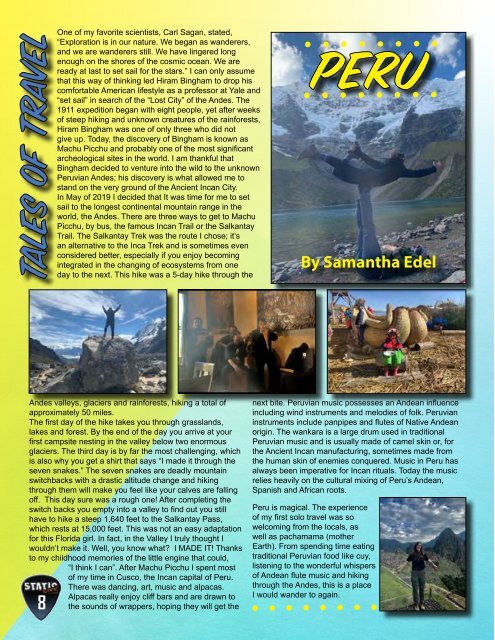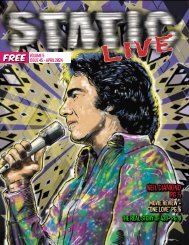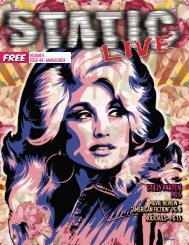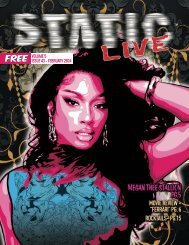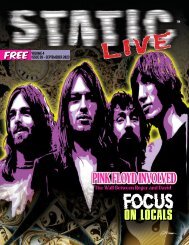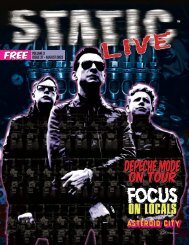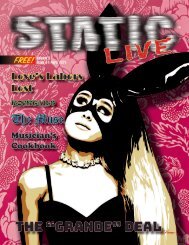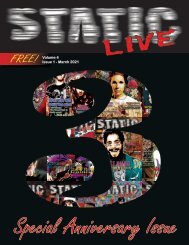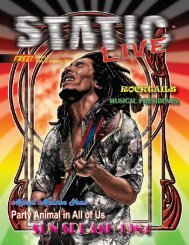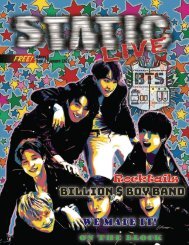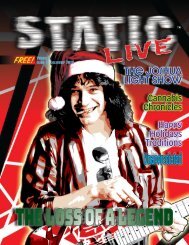Static Live Magazine August 2019
STATIC LIVE Magazine is Central Florida’s premier publication dedicated to celebrating music and culture. STATIC LIVE provides extensive, detailed community information from fashion to art, entertainment to events through noteworthy interviews, sensational photography and in-depth editorial coverage. STATIC LIVE is the only publication of its kind in Central Florida and reaches all target markets through wide distribution channels. Our staff includes highly accomplished contributors with award-winning backgrounds in music and entertainment; we know how much business is captured from the entertainment market. Our free full color publication can be found throughout Central Florida at key retailers, hotels and restaurants in high traffic areas. Our mission is to highlight the incredible talent, culture and lifestyle in Central Florida. With eye-opening profiles and coverage of the music and art community, STATIC LIVE readers will be positively influenced by our topical content and trending advertisers. STATIC LIVE Magazine is the most effective tool for branding connectivity with consumers in our area.
STATIC LIVE Magazine is Central Florida’s premier publication dedicated to celebrating music and culture. STATIC LIVE provides extensive, detailed community information from fashion to art, entertainment to events through noteworthy interviews, sensational photography and in-depth editorial coverage. STATIC LIVE is the only publication of its kind in Central Florida and reaches all target markets through wide distribution channels. Our staff includes highly accomplished contributors with award-winning backgrounds in music and entertainment; we know how much business is captured from the entertainment market. Our free full color publication can be found throughout Central Florida at key retailers, hotels and restaurants in high traffic areas. Our mission is to highlight the incredible talent, culture and lifestyle in Central Florida. With eye-opening profiles and coverage of the music and art community, STATIC LIVE readers will be positively influenced by our topical content and trending advertisers. STATIC LIVE Magazine is the most effective tool for branding connectivity with consumers in our area.
You also want an ePaper? Increase the reach of your titles
YUMPU automatically turns print PDFs into web optimized ePapers that Google loves.
One of my favorite scientists, Carl Sagan, stated,<br />
“Exploration is in our nature. We began as wanderers,<br />
and we are wanderers still. We have lingered long<br />
enough on the shores of the cosmic ocean. We are<br />
ready at last to set sail for the stars.” I can only assume<br />
that this way of thinking led Hiram Bingham to drop his<br />
comfortable American lifestyle as a professor at Yale and<br />
“set sail” in search of the “Lost City” of the Andes. The<br />
1911 expedition began with eight people, yet after weeks<br />
of steep hiking and unknown creatures of the rainforests,<br />
Hiram Bingham was one of only three who did not<br />
give up. Today, the discovery of Bingham is known as<br />
Machu Picchu and probably one of the most significant<br />
archeological sites in the world. I am thankful that<br />
Bingham decided to venture into the wild to the unknown<br />
Peruvian Andes; his discovery is what allowed me to<br />
stand on the very ground of the Ancient Incan City.<br />
In May of <strong>2019</strong> I decided that It was time for me to set<br />
sail to the longest continental mountain range in the<br />
world, the Andes. There are three ways to get to Machu<br />
Picchu, by bus, the famous Incan Trail or the Salkantay<br />
Trail. The Salkantay Trek was the route I chose; it’s<br />
an alternative to the Inca Trek and is sometimes even<br />
considered better, especially if you enjoy becoming<br />
integrated in the changing of ecosystems from one<br />
day to the next. This hike was a 5-day hike through the<br />
Andes valleys, glaciers and rainforests, hiking a total of<br />
approximately 50 miles.<br />
The first day of the hike takes you through grasslands,<br />
lakes and forest. By the end of the day you arrive at your<br />
first campsite nesting in the valley below two enormous<br />
glaciers. The third day is by far the most challenging, which<br />
is also why you get a shirt that says “I made it through the<br />
seven snakes.” The seven snakes are deadly mountain<br />
switchbacks with a drastic altitude change and hiking<br />
through them will make you feel like your calves are falling<br />
off. This day sure was a rough one! After completing the<br />
switch backs you empty into a valley to find out you still<br />
have to hike a steep 1,640 feet to the Salkantay Pass,<br />
which rests at 15,000 feet. This was not an easy adaptation<br />
for this Florida girl. In fact, in the Valley I truly thought I<br />
wouldn’t make it. Well, you know what? I MADE IT! Thanks<br />
to my childhood memories of the little engine that could,<br />
“I think I can”. After Machu Picchu I spent most<br />
of my time in Cusco, the Incan capital of Peru.<br />
There was dancing, art, music and alpacas.<br />
Alpacas really enjoy cliff bars and are drawn to<br />
the sounds of wrappers, hoping they will get the<br />
8<br />
next bite. Peruvian music possesses an Andean influence<br />
including wind instruments and melodies of folk. Peruvian<br />
instruments include panpipes and flutes of Native Andean<br />
origin. The wankara is a large drum used in traditional<br />
Peruvian music and is usually made of camel skin or, for<br />
the Ancient Incan manufacturing, sometimes made from<br />
the human skin of enemies conquered. Music in Peru has<br />
always been imperative for Incan rituals. Today the music<br />
relies heavily on the cultural mixing of Peru’s Andean,<br />
Spanish and African roots.<br />
Peru is magical. The experience<br />
of my first solo travel was so<br />
welcoming from the locals, as<br />
well as pachamama (mother<br />
Earth). From spending time eating<br />
traditional Peruvian food like cuy,<br />
listening to the wonderful whispers<br />
of Andean flute music and hiking<br />
through the Andes, this is a place<br />
I would wander to again.<br />
By Hank Harrison<br />
Everybody knows Nirvana was a drop-dead classic band, but Steve Albini,<br />
their best producer, is a sound maker who goes back to Big Black and<br />
remains an all around Zen Master. In fact, Albini, who hates the system with<br />
integrity, has survived more than two decades managing to turn on second<br />
generation fans, old Jazz farts like me, and curious listeners from Brazil to<br />
Moscow.<br />
Steve was born in Pasadena, California, but by 1974 he wound up in<br />
Missoula, Montana, of all strange places, making guitars, of all strange things.<br />
In High School, he began taking bass lessons while recovering from a broken<br />
leg. This was right in the middle of the punk wave and The Ramons banged<br />
him at age 15. That exposure fed red meat to his lust for sound, which, in<br />
turn, led him to The Stooges. Soon after a mix of really complex and mostly<br />
experimental bands arrived. This early list included Suicide, Wire, The Fall,<br />
The Velvet Underground, Throbbing Gristle, Kraftwerk, The Birthday Party,<br />
Pere Ubu, Public Image, Rudimentary Peni, and Killing Joke. These bands<br />
also gave the vision to see beyond the commercial and for-profit world.<br />
After graduating High School, Steve moved to Evanston, Illinois when he<br />
got accepted to school at Northwestern. I assume he got a top test score<br />
because he moved away from mom and dad at that point. A few years went<br />
by and Albini showed he was tolerant of idiots by graduating. He often said he<br />
learned more about Art than Journalism at Northwestern. I can see where he<br />
got his eclectic education but the school still has a whole lot going<br />
for it on many levels; even the football team is pretty good most<br />
seasons. Once he hit the bricks, Albini started writing for several<br />
Chicago ZzzINES and created a small sensation by writing, “Where<br />
to hear the hottest bands”, articles for Forced Exposure.<br />
9


